Managers and Leaders: Employee Development Strategies at M&S
VerifiedAdded on 2023/06/18
|35
|8474
|492
Report
AI Summary
This report investigates the role of line managers and leaders in employee development within Marks & Spencer, aiming to understand the strategies they employ and the challenges they face. The research utilizes a deductive approach and survey strategy to gather primary data. The literature review explores the concept of managerial influence, various development strategies, and the issues encountered during implementation, such as lack of acknowledgement and communication. The study highlights the importance of leadership in fostering employee engagement and achieving organizational goals. This assignment, along with other solved assignments, is available on Desklib for students seeking comprehensive study resources.

Research Project
Paraphrase This Document
Need a fresh take? Get an instant paraphrase of this document with our AI Paraphraser

Contents
Chapter One: Introduction...............................................................................................................3
1.1 Research Aim.........................................................................................................................3
Rationale for the research............................................................................................................3
1.2 Research Questions................................................................................................................4
1.3 Research Objectives...............................................................................................................4
1.4 Significance of the Research.................................................................................................4
Chapter Two: Literature Review.....................................................................................................4
2.1 Introduction of Literature Review.........................................................................................4
2.2 Main Body.............................................................................................................................5
2.3 Conclusion of Literature Review...........................................................................................7
Chapter Three: Methodology...........................................................................................................7
3.1 Research Approach................................................................................................................7
3.2 Research Strategy..................................................................................................................7
3.3 Research Methodology..........................................................................................................7
3.4 Research Tools.......................................................................................................................8
3.5 Sampling................................................................................................................................8
3.5.1 Identifying Population and Research Site...........................................................................8
3.5.2 Sampling Strategy...............................................................................................................8
Chapter Four: Findings (Data Analysis and Presentation)............................................................10
Chapter Five: Discussion (Data Interpretation).............................................................................15
Chapter Six: Conclusion, Recommendations and Implications for Further Research..................16
REFERENCES..............................................................................................................................19
APPENDIX....................................................................................................................................20
Chapter One: Introduction...............................................................................................................3
1.1 Research Aim.........................................................................................................................3
Rationale for the research............................................................................................................3
1.2 Research Questions................................................................................................................4
1.3 Research Objectives...............................................................................................................4
1.4 Significance of the Research.................................................................................................4
Chapter Two: Literature Review.....................................................................................................4
2.1 Introduction of Literature Review.........................................................................................4
2.2 Main Body.............................................................................................................................5
2.3 Conclusion of Literature Review...........................................................................................7
Chapter Three: Methodology...........................................................................................................7
3.1 Research Approach................................................................................................................7
3.2 Research Strategy..................................................................................................................7
3.3 Research Methodology..........................................................................................................7
3.4 Research Tools.......................................................................................................................8
3.5 Sampling................................................................................................................................8
3.5.1 Identifying Population and Research Site...........................................................................8
3.5.2 Sampling Strategy...............................................................................................................8
Chapter Four: Findings (Data Analysis and Presentation)............................................................10
Chapter Five: Discussion (Data Interpretation).............................................................................15
Chapter Six: Conclusion, Recommendations and Implications for Further Research..................16
REFERENCES..............................................................................................................................19
APPENDIX....................................................................................................................................20
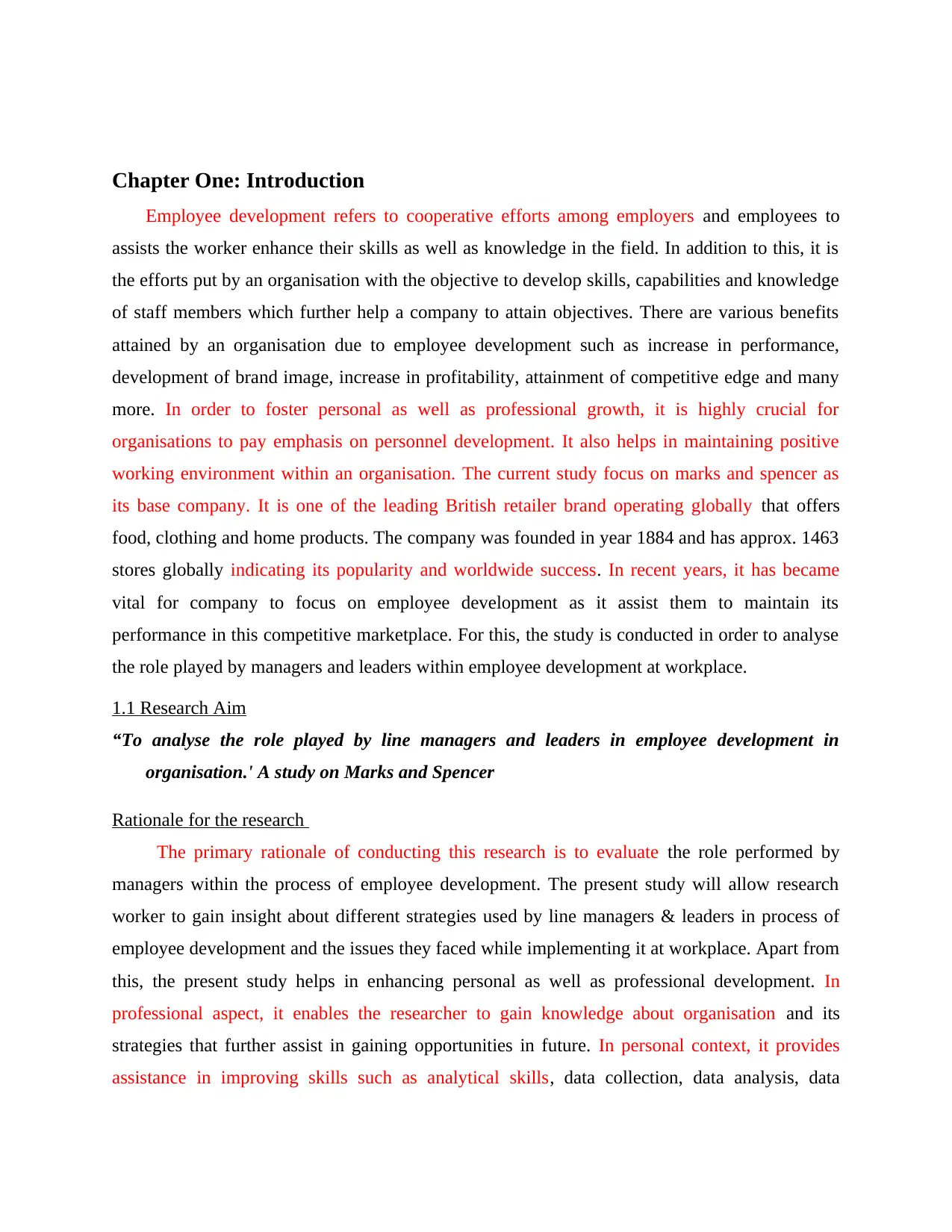
Chapter One: Introduction
Employee development refers to cooperative efforts among employers and employees to
assists the worker enhance their skills as well as knowledge in the field. In addition to this, it is
the efforts put by an organisation with the objective to develop skills, capabilities and knowledge
of staff members which further help a company to attain objectives. There are various benefits
attained by an organisation due to employee development such as increase in performance,
development of brand image, increase in profitability, attainment of competitive edge and many
more. In order to foster personal as well as professional growth, it is highly crucial for
organisations to pay emphasis on personnel development. It also helps in maintaining positive
working environment within an organisation. The current study focus on marks and spencer as
its base company. It is one of the leading British retailer brand operating globally that offers
food, clothing and home products. The company was founded in year 1884 and has approx. 1463
stores globally indicating its popularity and worldwide success. In recent years, it has became
vital for company to focus on employee development as it assist them to maintain its
performance in this competitive marketplace. For this, the study is conducted in order to analyse
the role played by managers and leaders within employee development at workplace.
1.1 Research Aim
“To analyse the role played by line managers and leaders in employee development in
organisation.' A study on Marks and Spencer
Rationale for the research
The primary rationale of conducting this research is to evaluate the role performed by
managers within the process of employee development. The present study will allow research
worker to gain insight about different strategies used by line managers & leaders in process of
employee development and the issues they faced while implementing it at workplace. Apart from
this, the present study helps in enhancing personal as well as professional development. In
professional aspect, it enables the researcher to gain knowledge about organisation and its
strategies that further assist in gaining opportunities in future. In personal context, it provides
assistance in improving skills such as analytical skills, data collection, data analysis, data
Employee development refers to cooperative efforts among employers and employees to
assists the worker enhance their skills as well as knowledge in the field. In addition to this, it is
the efforts put by an organisation with the objective to develop skills, capabilities and knowledge
of staff members which further help a company to attain objectives. There are various benefits
attained by an organisation due to employee development such as increase in performance,
development of brand image, increase in profitability, attainment of competitive edge and many
more. In order to foster personal as well as professional growth, it is highly crucial for
organisations to pay emphasis on personnel development. It also helps in maintaining positive
working environment within an organisation. The current study focus on marks and spencer as
its base company. It is one of the leading British retailer brand operating globally that offers
food, clothing and home products. The company was founded in year 1884 and has approx. 1463
stores globally indicating its popularity and worldwide success. In recent years, it has became
vital for company to focus on employee development as it assist them to maintain its
performance in this competitive marketplace. For this, the study is conducted in order to analyse
the role played by managers and leaders within employee development at workplace.
1.1 Research Aim
“To analyse the role played by line managers and leaders in employee development in
organisation.' A study on Marks and Spencer
Rationale for the research
The primary rationale of conducting this research is to evaluate the role performed by
managers within the process of employee development. The present study will allow research
worker to gain insight about different strategies used by line managers & leaders in process of
employee development and the issues they faced while implementing it at workplace. Apart from
this, the present study helps in enhancing personal as well as professional development. In
professional aspect, it enables the researcher to gain knowledge about organisation and its
strategies that further assist in gaining opportunities in future. In personal context, it provides
assistance in improving skills such as analytical skills, data collection, data analysis, data
⊘ This is a preview!⊘
Do you want full access?
Subscribe today to unlock all pages.

Trusted by 1+ million students worldwide
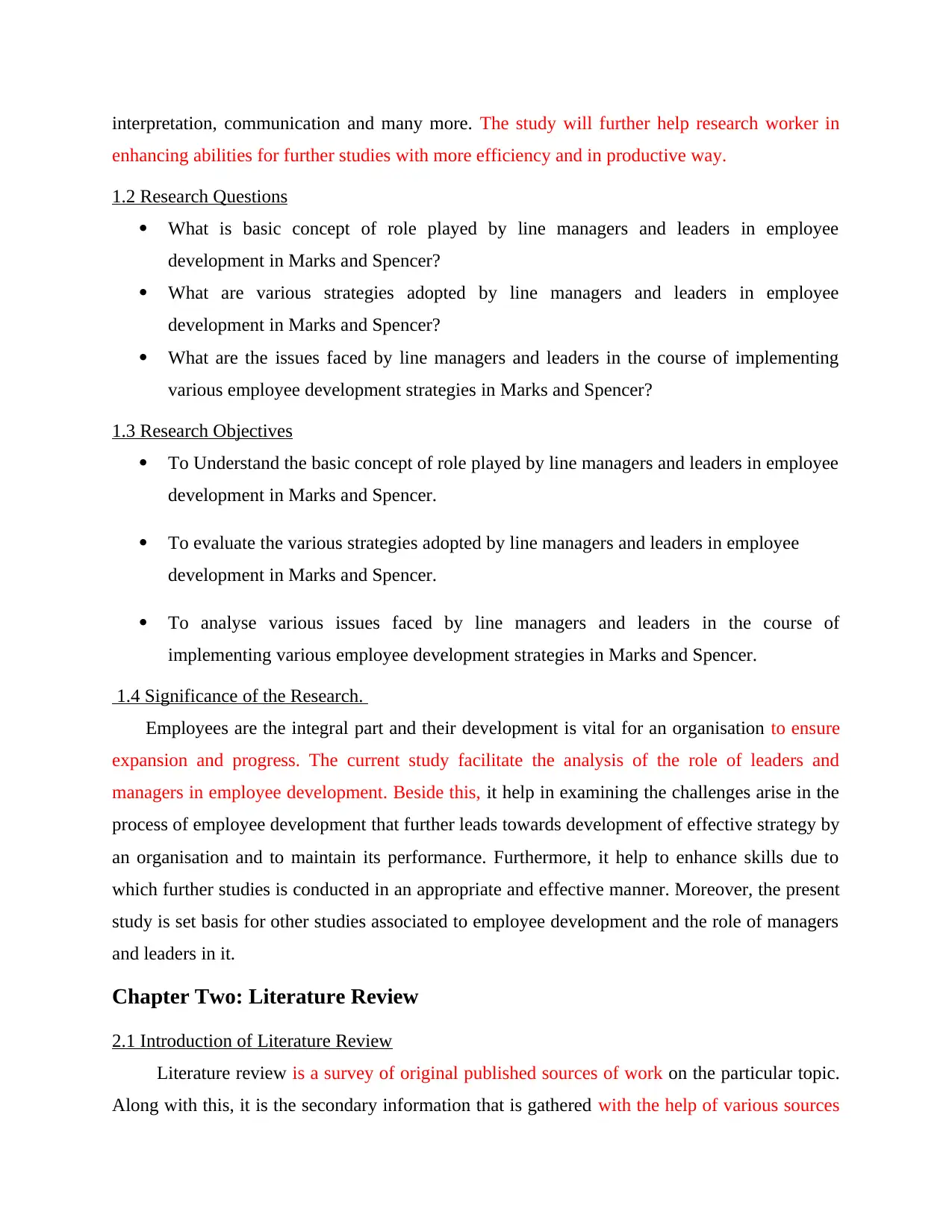
interpretation, communication and many more. The study will further help research worker in
enhancing abilities for further studies with more efficiency and in productive way.
1.2 Research Questions
What is basic concept of role played by line managers and leaders in employee
development in Marks and Spencer?
What are various strategies adopted by line managers and leaders in employee
development in Marks and Spencer?
What are the issues faced by line managers and leaders in the course of implementing
various employee development strategies in Marks and Spencer?
1.3 Research Objectives
To Understand the basic concept of role played by line managers and leaders in employee
development in Marks and Spencer.
To evaluate the various strategies adopted by line managers and leaders in employee
development in Marks and Spencer.
To analyse various issues faced by line managers and leaders in the course of
implementing various employee development strategies in Marks and Spencer.
1.4 Significance of the Research.
Employees are the integral part and their development is vital for an organisation to ensure
expansion and progress. The current study facilitate the analysis of the role of leaders and
managers in employee development. Beside this, it help in examining the challenges arise in the
process of employee development that further leads towards development of effective strategy by
an organisation and to maintain its performance. Furthermore, it help to enhance skills due to
which further studies is conducted in an appropriate and effective manner. Moreover, the present
study is set basis for other studies associated to employee development and the role of managers
and leaders in it.
Chapter Two: Literature Review
2.1 Introduction of Literature Review
Literature review is a survey of original published sources of work on the particular topic.
Along with this, it is the secondary information that is gathered with the help of various sources
enhancing abilities for further studies with more efficiency and in productive way.
1.2 Research Questions
What is basic concept of role played by line managers and leaders in employee
development in Marks and Spencer?
What are various strategies adopted by line managers and leaders in employee
development in Marks and Spencer?
What are the issues faced by line managers and leaders in the course of implementing
various employee development strategies in Marks and Spencer?
1.3 Research Objectives
To Understand the basic concept of role played by line managers and leaders in employee
development in Marks and Spencer.
To evaluate the various strategies adopted by line managers and leaders in employee
development in Marks and Spencer.
To analyse various issues faced by line managers and leaders in the course of
implementing various employee development strategies in Marks and Spencer.
1.4 Significance of the Research.
Employees are the integral part and their development is vital for an organisation to ensure
expansion and progress. The current study facilitate the analysis of the role of leaders and
managers in employee development. Beside this, it help in examining the challenges arise in the
process of employee development that further leads towards development of effective strategy by
an organisation and to maintain its performance. Furthermore, it help to enhance skills due to
which further studies is conducted in an appropriate and effective manner. Moreover, the present
study is set basis for other studies associated to employee development and the role of managers
and leaders in it.
Chapter Two: Literature Review
2.1 Introduction of Literature Review
Literature review is a survey of original published sources of work on the particular topic.
Along with this, it is the secondary information that is gathered with the help of various sources
Paraphrase This Document
Need a fresh take? Get an instant paraphrase of this document with our AI Paraphraser
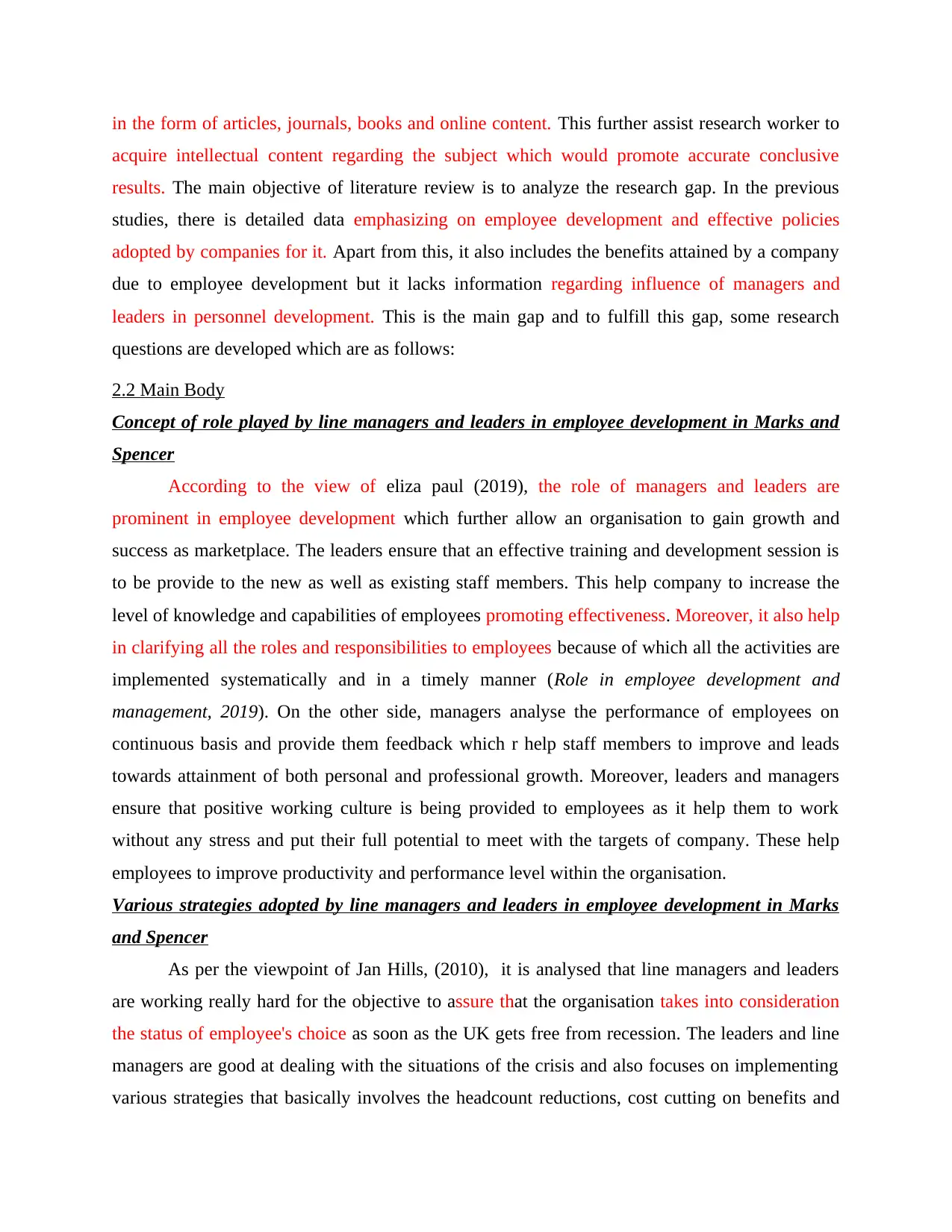
in the form of articles, journals, books and online content. This further assist research worker to
acquire intellectual content regarding the subject which would promote accurate conclusive
results. The main objective of literature review is to analyze the research gap. In the previous
studies, there is detailed data emphasizing on employee development and effective policies
adopted by companies for it. Apart from this, it also includes the benefits attained by a company
due to employee development but it lacks information regarding influence of managers and
leaders in personnel development. This is the main gap and to fulfill this gap, some research
questions are developed which are as follows:
2.2 Main Body
Concept of role played by line managers and leaders in employee development in Marks and
Spencer
According to the view of eliza paul (2019), the role of managers and leaders are
prominent in employee development which further allow an organisation to gain growth and
success as marketplace. The leaders ensure that an effective training and development session is
to be provide to the new as well as existing staff members. This help company to increase the
level of knowledge and capabilities of employees promoting effectiveness. Moreover, it also help
in clarifying all the roles and responsibilities to employees because of which all the activities are
implemented systematically and in a timely manner (Role in employee development and
management, 2019). On the other side, managers analyse the performance of employees on
continuous basis and provide them feedback which r help staff members to improve and leads
towards attainment of both personal and professional growth. Moreover, leaders and managers
ensure that positive working culture is being provided to employees as it help them to work
without any stress and put their full potential to meet with the targets of company. These help
employees to improve productivity and performance level within the organisation.
Various strategies adopted by line managers and leaders in employee development in Marks
and Spencer
As per the viewpoint of Jan Hills, (2010), it is analysed that line managers and leaders
are working really hard for the objective to assure that the organisation takes into consideration
the status of employee's choice as soon as the UK gets free from recession. The leaders and line
managers are good at dealing with the situations of the crisis and also focuses on implementing
various strategies that basically involves the headcount reductions, cost cutting on benefits and
acquire intellectual content regarding the subject which would promote accurate conclusive
results. The main objective of literature review is to analyze the research gap. In the previous
studies, there is detailed data emphasizing on employee development and effective policies
adopted by companies for it. Apart from this, it also includes the benefits attained by a company
due to employee development but it lacks information regarding influence of managers and
leaders in personnel development. This is the main gap and to fulfill this gap, some research
questions are developed which are as follows:
2.2 Main Body
Concept of role played by line managers and leaders in employee development in Marks and
Spencer
According to the view of eliza paul (2019), the role of managers and leaders are
prominent in employee development which further allow an organisation to gain growth and
success as marketplace. The leaders ensure that an effective training and development session is
to be provide to the new as well as existing staff members. This help company to increase the
level of knowledge and capabilities of employees promoting effectiveness. Moreover, it also help
in clarifying all the roles and responsibilities to employees because of which all the activities are
implemented systematically and in a timely manner (Role in employee development and
management, 2019). On the other side, managers analyse the performance of employees on
continuous basis and provide them feedback which r help staff members to improve and leads
towards attainment of both personal and professional growth. Moreover, leaders and managers
ensure that positive working culture is being provided to employees as it help them to work
without any stress and put their full potential to meet with the targets of company. These help
employees to improve productivity and performance level within the organisation.
Various strategies adopted by line managers and leaders in employee development in Marks
and Spencer
As per the viewpoint of Jan Hills, (2010), it is analysed that line managers and leaders
are working really hard for the objective to assure that the organisation takes into consideration
the status of employee's choice as soon as the UK gets free from recession. The leaders and line
managers are good at dealing with the situations of the crisis and also focuses on implementing
various strategies that basically involves the headcount reductions, cost cutting on benefits and

training. In context to Marks and Spencer, the business partners are fully focusing on the agenda
of talent and are efficiently working with line managers for the objective of identifying the talent
and creating and developing plans according to the individuals for the purpose to ensure that they
are understanding the career and growth opportunities which the organisation is offering them
that also further involves the succession paths and planning cover. In addition to this, the
organisation is also focusing on enhancing the process of Marks and Spencer’s employer brand
and more on employee engagement and employee development. It also involves conducting
various surveys for the purpose to increase the level of motivation among the workforce and also
assessing various issues and even supporting managers to take necessary actions whenever
required. The line managers and leaders are taking necessary measures to ensure that proper
strategy is implemented in order to get the desired results and also contributing in providing the
best business results and making a efficient and effective line management team.
Issues faced by line managers and leaders in the course of implementing various employee
development strategies in Marks and Spencer
According to Paul Polman and CB Bhattacharya, (2016), there are several challenges that
managers and leaders have to deal with for the purpose to implement various employee
development strategies in the organisation which basically involves lack of acknowledgement
and lack of personal involvement from the leader and line managers side which resulted in
creation and implementation of the desired strategies. The business managers of the organisation
need to understand the important of various issues which also involves sustainability issues. It is
very important to understand the need, desire and objective of each and every employee and
afterwards formulating the strategies according to their needs and keeping in mind organisational
goals. The line managers and leaders need to think beyond the financial benefits in order to
enhance the employee development process. Moreover, in order to implement effective strategies
in the organisation it is very important to work on company’s culture, managing and enhancing
the communication as lack of proper communication is another issue that need to be addressed
carefully while implementing the desired strategies, it is also important to address the wellbeing
of the employees and tracking productivity of the team in a timely manner plus supporting
inclusion and diversity in the workplace and also focusing on on boarding and recruiting the
right employees in the organisation.
of talent and are efficiently working with line managers for the objective of identifying the talent
and creating and developing plans according to the individuals for the purpose to ensure that they
are understanding the career and growth opportunities which the organisation is offering them
that also further involves the succession paths and planning cover. In addition to this, the
organisation is also focusing on enhancing the process of Marks and Spencer’s employer brand
and more on employee engagement and employee development. It also involves conducting
various surveys for the purpose to increase the level of motivation among the workforce and also
assessing various issues and even supporting managers to take necessary actions whenever
required. The line managers and leaders are taking necessary measures to ensure that proper
strategy is implemented in order to get the desired results and also contributing in providing the
best business results and making a efficient and effective line management team.
Issues faced by line managers and leaders in the course of implementing various employee
development strategies in Marks and Spencer
According to Paul Polman and CB Bhattacharya, (2016), there are several challenges that
managers and leaders have to deal with for the purpose to implement various employee
development strategies in the organisation which basically involves lack of acknowledgement
and lack of personal involvement from the leader and line managers side which resulted in
creation and implementation of the desired strategies. The business managers of the organisation
need to understand the important of various issues which also involves sustainability issues. It is
very important to understand the need, desire and objective of each and every employee and
afterwards formulating the strategies according to their needs and keeping in mind organisational
goals. The line managers and leaders need to think beyond the financial benefits in order to
enhance the employee development process. Moreover, in order to implement effective strategies
in the organisation it is very important to work on company’s culture, managing and enhancing
the communication as lack of proper communication is another issue that need to be addressed
carefully while implementing the desired strategies, it is also important to address the wellbeing
of the employees and tracking productivity of the team in a timely manner plus supporting
inclusion and diversity in the workplace and also focusing on on boarding and recruiting the
right employees in the organisation.
⊘ This is a preview!⊘
Do you want full access?
Subscribe today to unlock all pages.

Trusted by 1+ million students worldwide
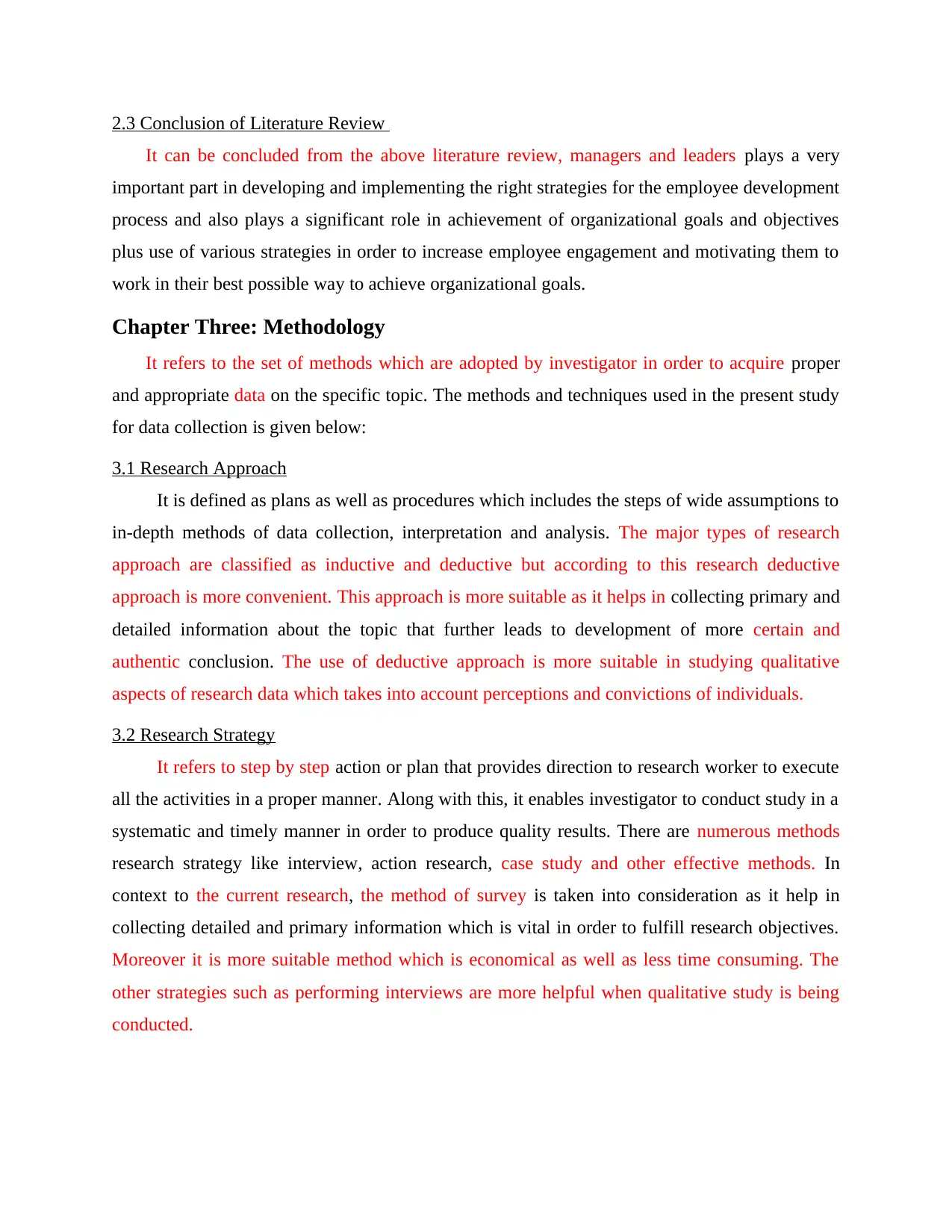
2.3 Conclusion of Literature Review
It can be concluded from the above literature review, managers and leaders plays a very
important part in developing and implementing the right strategies for the employee development
process and also plays a significant role in achievement of organizational goals and objectives
plus use of various strategies in order to increase employee engagement and motivating them to
work in their best possible way to achieve organizational goals.
Chapter Three: Methodology
It refers to the set of methods which are adopted by investigator in order to acquire proper
and appropriate data on the specific topic. The methods and techniques used in the present study
for data collection is given below:
3.1 Research Approach
It is defined as plans as well as procedures which includes the steps of wide assumptions to
in-depth methods of data collection, interpretation and analysis. The major types of research
approach are classified as inductive and deductive but according to this research deductive
approach is more convenient. This approach is more suitable as it helps in collecting primary and
detailed information about the topic that further leads to development of more certain and
authentic conclusion. The use of deductive approach is more suitable in studying qualitative
aspects of research data which takes into account perceptions and convictions of individuals.
3.2 Research Strategy
It refers to step by step action or plan that provides direction to research worker to execute
all the activities in a proper manner. Along with this, it enables investigator to conduct study in a
systematic and timely manner in order to produce quality results. There are numerous methods
research strategy like interview, action research, case study and other effective methods. In
context to the current research, the method of survey is taken into consideration as it help in
collecting detailed and primary information which is vital in order to fulfill research objectives.
Moreover it is more suitable method which is economical as well as less time consuming. The
other strategies such as performing interviews are more helpful when qualitative study is being
conducted.
It can be concluded from the above literature review, managers and leaders plays a very
important part in developing and implementing the right strategies for the employee development
process and also plays a significant role in achievement of organizational goals and objectives
plus use of various strategies in order to increase employee engagement and motivating them to
work in their best possible way to achieve organizational goals.
Chapter Three: Methodology
It refers to the set of methods which are adopted by investigator in order to acquire proper
and appropriate data on the specific topic. The methods and techniques used in the present study
for data collection is given below:
3.1 Research Approach
It is defined as plans as well as procedures which includes the steps of wide assumptions to
in-depth methods of data collection, interpretation and analysis. The major types of research
approach are classified as inductive and deductive but according to this research deductive
approach is more convenient. This approach is more suitable as it helps in collecting primary and
detailed information about the topic that further leads to development of more certain and
authentic conclusion. The use of deductive approach is more suitable in studying qualitative
aspects of research data which takes into account perceptions and convictions of individuals.
3.2 Research Strategy
It refers to step by step action or plan that provides direction to research worker to execute
all the activities in a proper manner. Along with this, it enables investigator to conduct study in a
systematic and timely manner in order to produce quality results. There are numerous methods
research strategy like interview, action research, case study and other effective methods. In
context to the current research, the method of survey is taken into consideration as it help in
collecting detailed and primary information which is vital in order to fulfill research objectives.
Moreover it is more suitable method which is economical as well as less time consuming. The
other strategies such as performing interviews are more helpful when qualitative study is being
conducted.
Paraphrase This Document
Need a fresh take? Get an instant paraphrase of this document with our AI Paraphraser

3.3 Research Methodology
It refers to the set of procedures which allow investigator to gain information on the
specific topic. Additionally, this is an important part of a research as the overall study is based on
it. The two major classification of research methods are qualitative and quantitative. As per the
specifications of current study, quantitative method is preferred as it support facts with
numerical data and statistics. Along with this, it helps in acquisition of data which is more
reliable and supports more convenient results. The qualitative aspects of data are supported with
views and notions of individuals through performing interviews and methods of qualitative
research. Whereas quantitative aspects of data helps in obtaining more accurate outcomes
through emphasizing focus upon figures and numerical form of data.
3.4 Research Tools
It is defined as the methods and techniques that is adopted in the process of conducting
research. There are majorly two categories of research tools that is primary and secondary.
Primary information refers to the data which presents first hand information and is original
source of information. The methods of obtaining primary data are through making questionnaire
or conducting interviews etc. On the other hand, secondary data includes information which is
previously gathered and is existing as well. In context to the current project, both methods of
collecting data is convenient to use. To facilitate collection of primary data, questionnaire is used
as it helps in assisting in-depth knowledge about topic. On the other side, secondary data is
gathered with the help of books, Journals, articles and so on.
3.5 Sampling
It is the technique applied by researcher for the purpose of selecting sample size from total
population. The two main classifications of sampling are probability and non-probability
sampling method.
3.5.1 Identifying Population and Research Site
In the current study, the 40 employees of Marks and Spencer is chosen as participants. The
primary concern behind selecting employees as participants is that they are familiar about ground
workings of company due to which they are able to share experience based information and more
suitable data to researcher. This further leads to attainment of positive and valid conclusion.
It refers to the set of procedures which allow investigator to gain information on the
specific topic. Additionally, this is an important part of a research as the overall study is based on
it. The two major classification of research methods are qualitative and quantitative. As per the
specifications of current study, quantitative method is preferred as it support facts with
numerical data and statistics. Along with this, it helps in acquisition of data which is more
reliable and supports more convenient results. The qualitative aspects of data are supported with
views and notions of individuals through performing interviews and methods of qualitative
research. Whereas quantitative aspects of data helps in obtaining more accurate outcomes
through emphasizing focus upon figures and numerical form of data.
3.4 Research Tools
It is defined as the methods and techniques that is adopted in the process of conducting
research. There are majorly two categories of research tools that is primary and secondary.
Primary information refers to the data which presents first hand information and is original
source of information. The methods of obtaining primary data are through making questionnaire
or conducting interviews etc. On the other hand, secondary data includes information which is
previously gathered and is existing as well. In context to the current project, both methods of
collecting data is convenient to use. To facilitate collection of primary data, questionnaire is used
as it helps in assisting in-depth knowledge about topic. On the other side, secondary data is
gathered with the help of books, Journals, articles and so on.
3.5 Sampling
It is the technique applied by researcher for the purpose of selecting sample size from total
population. The two main classifications of sampling are probability and non-probability
sampling method.
3.5.1 Identifying Population and Research Site
In the current study, the 40 employees of Marks and Spencer is chosen as participants. The
primary concern behind selecting employees as participants is that they are familiar about ground
workings of company due to which they are able to share experience based information and more
suitable data to researcher. This further leads to attainment of positive and valid conclusion.
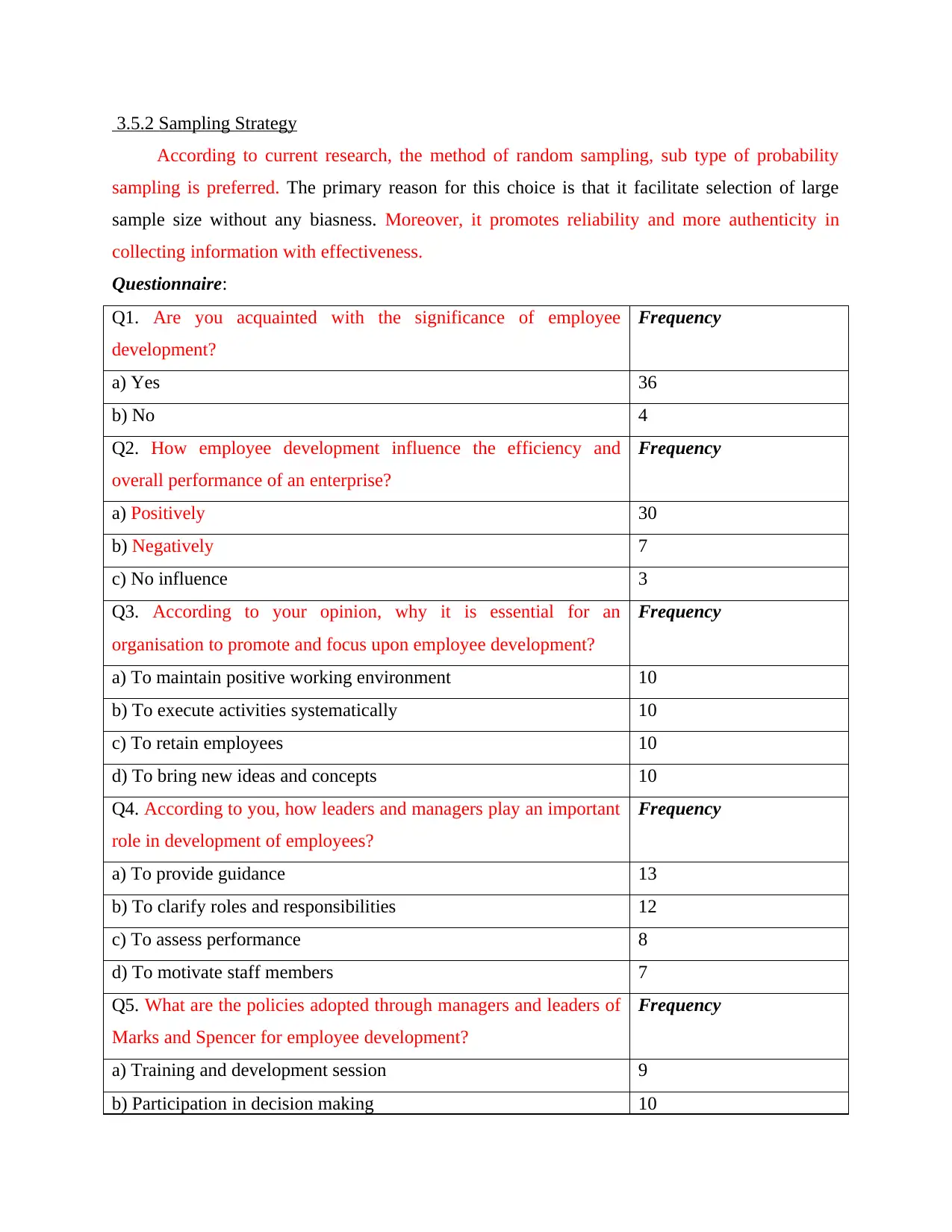
3.5.2 Sampling Strategy
According to current research, the method of random sampling, sub type of probability
sampling is preferred. The primary reason for this choice is that it facilitate selection of large
sample size without any biasness. Moreover, it promotes reliability and more authenticity in
collecting information with effectiveness.
Questionnaire:
Q1. Are you acquainted with the significance of employee
development?
Frequency
a) Yes 36
b) No 4
Q2. How employee development influence the efficiency and
overall performance of an enterprise?
Frequency
a) Positively 30
b) Negatively 7
c) No influence 3
Q3. According to your opinion, why it is essential for an
organisation to promote and focus upon employee development?
Frequency
a) To maintain positive working environment 10
b) To execute activities systematically 10
c) To retain employees 10
d) To bring new ideas and concepts 10
Q4. According to you, how leaders and managers play an important
role in development of employees?
Frequency
a) To provide guidance 13
b) To clarify roles and responsibilities 12
c) To assess performance 8
d) To motivate staff members 7
Q5. What are the policies adopted through managers and leaders of
Marks and Spencer for employee development?
Frequency
a) Training and development session 9
b) Participation in decision making 10
According to current research, the method of random sampling, sub type of probability
sampling is preferred. The primary reason for this choice is that it facilitate selection of large
sample size without any biasness. Moreover, it promotes reliability and more authenticity in
collecting information with effectiveness.
Questionnaire:
Q1. Are you acquainted with the significance of employee
development?
Frequency
a) Yes 36
b) No 4
Q2. How employee development influence the efficiency and
overall performance of an enterprise?
Frequency
a) Positively 30
b) Negatively 7
c) No influence 3
Q3. According to your opinion, why it is essential for an
organisation to promote and focus upon employee development?
Frequency
a) To maintain positive working environment 10
b) To execute activities systematically 10
c) To retain employees 10
d) To bring new ideas and concepts 10
Q4. According to you, how leaders and managers play an important
role in development of employees?
Frequency
a) To provide guidance 13
b) To clarify roles and responsibilities 12
c) To assess performance 8
d) To motivate staff members 7
Q5. What are the policies adopted through managers and leaders of
Marks and Spencer for employee development?
Frequency
a) Training and development session 9
b) Participation in decision making 10
⊘ This is a preview!⊘
Do you want full access?
Subscribe today to unlock all pages.

Trusted by 1+ million students worldwide
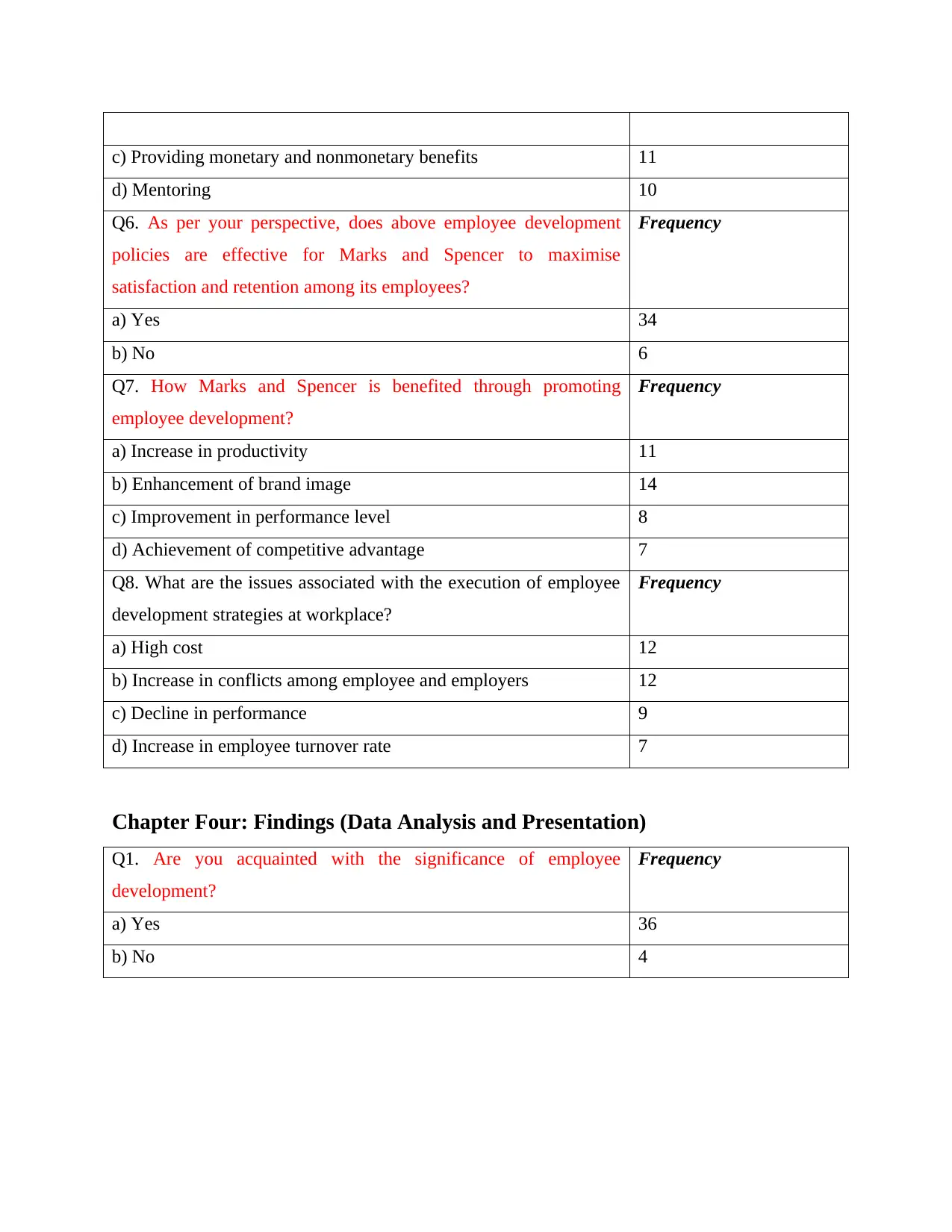
c) Providing monetary and nonmonetary benefits 11
d) Mentoring 10
Q6. As per your perspective, does above employee development
policies are effective for Marks and Spencer to maximise
satisfaction and retention among its employees?
Frequency
a) Yes 34
b) No 6
Q7. How Marks and Spencer is benefited through promoting
employee development?
Frequency
a) Increase in productivity 11
b) Enhancement of brand image 14
c) Improvement in performance level 8
d) Achievement of competitive advantage 7
Q8. What are the issues associated with the execution of employee
development strategies at workplace?
Frequency
a) High cost 12
b) Increase in conflicts among employee and employers 12
c) Decline in performance 9
d) Increase in employee turnover rate 7
Chapter Four: Findings (Data Analysis and Presentation)
Q1. Are you acquainted with the significance of employee
development?
Frequency
a) Yes 36
b) No 4
d) Mentoring 10
Q6. As per your perspective, does above employee development
policies are effective for Marks and Spencer to maximise
satisfaction and retention among its employees?
Frequency
a) Yes 34
b) No 6
Q7. How Marks and Spencer is benefited through promoting
employee development?
Frequency
a) Increase in productivity 11
b) Enhancement of brand image 14
c) Improvement in performance level 8
d) Achievement of competitive advantage 7
Q8. What are the issues associated with the execution of employee
development strategies at workplace?
Frequency
a) High cost 12
b) Increase in conflicts among employee and employers 12
c) Decline in performance 9
d) Increase in employee turnover rate 7
Chapter Four: Findings (Data Analysis and Presentation)
Q1. Are you acquainted with the significance of employee
development?
Frequency
a) Yes 36
b) No 4
Paraphrase This Document
Need a fresh take? Get an instant paraphrase of this document with our AI Paraphraser

Q2. How employee development influence the efficiency and
overall performance of an enterprise?
Frequency
a) Positively 30
b) Negatively 7
c) No influence 3
Q3. According to your opinion, why it is essential for an Frequency
overall performance of an enterprise?
Frequency
a) Positively 30
b) Negatively 7
c) No influence 3
Q3. According to your opinion, why it is essential for an Frequency
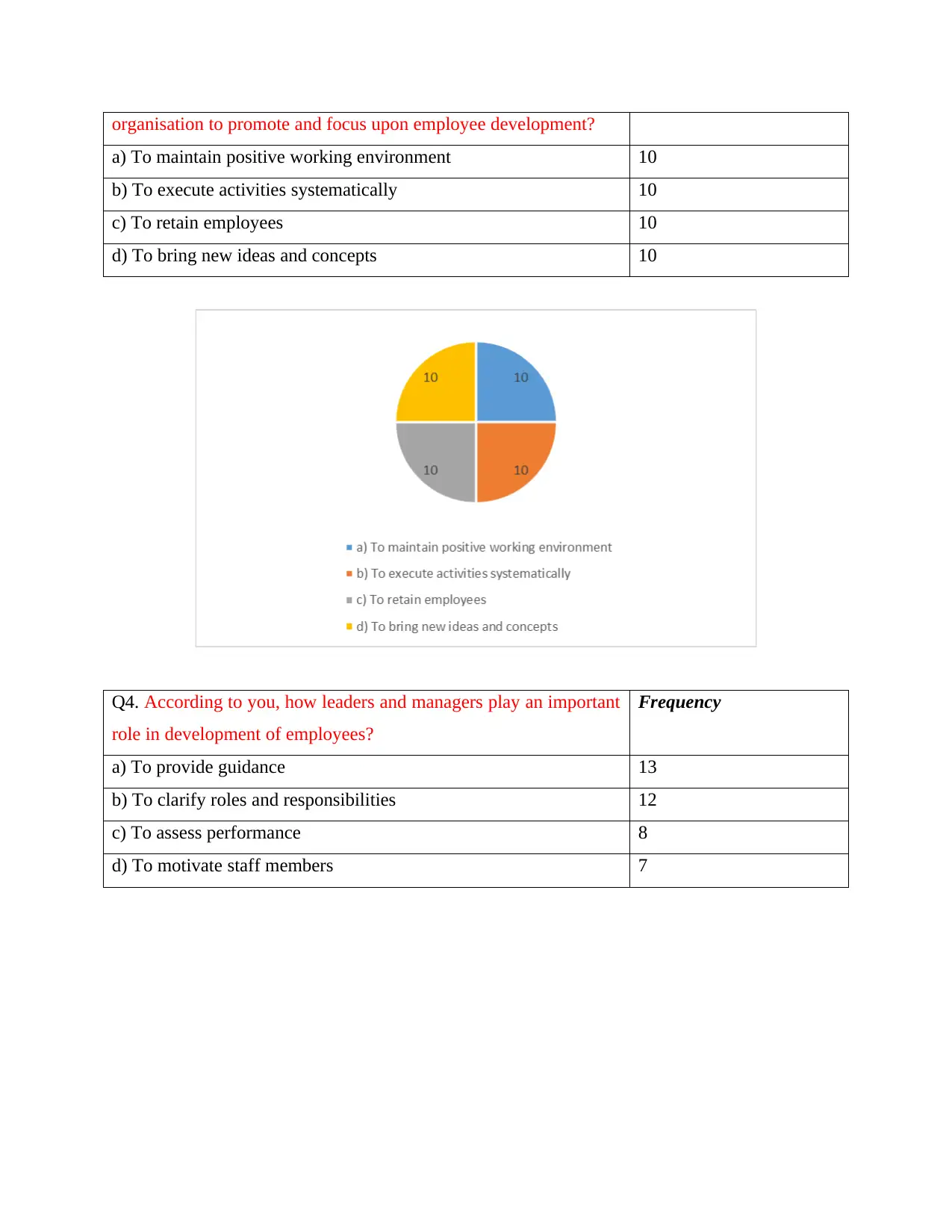
organisation to promote and focus upon employee development?
a) To maintain positive working environment 10
b) To execute activities systematically 10
c) To retain employees 10
d) To bring new ideas and concepts 10
Q4. According to you, how leaders and managers play an important
role in development of employees?
Frequency
a) To provide guidance 13
b) To clarify roles and responsibilities 12
c) To assess performance 8
d) To motivate staff members 7
a) To maintain positive working environment 10
b) To execute activities systematically 10
c) To retain employees 10
d) To bring new ideas and concepts 10
Q4. According to you, how leaders and managers play an important
role in development of employees?
Frequency
a) To provide guidance 13
b) To clarify roles and responsibilities 12
c) To assess performance 8
d) To motivate staff members 7
⊘ This is a preview!⊘
Do you want full access?
Subscribe today to unlock all pages.

Trusted by 1+ million students worldwide
1 out of 35
Related Documents
Your All-in-One AI-Powered Toolkit for Academic Success.
+13062052269
info@desklib.com
Available 24*7 on WhatsApp / Email
![[object Object]](/_next/static/media/star-bottom.7253800d.svg)
Unlock your academic potential
Copyright © 2020–2025 A2Z Services. All Rights Reserved. Developed and managed by ZUCOL.





